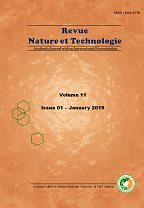Investigation of air velocity effect on thermal comfort in mosques-hot- dry climate
Keywords:
Adaptive Comfort, Eloued City, Chimney effect, Air speedAbstract
In hot climate areas, the proper understanding of thermal comfort parameters leads to help building designers in providing a suitable and refreshing environment for occupants. The rational model such as ASHRAE 55/2013, ISO: 7730 defines comfort boundaries based on the experimental results, which are conducted in climatic chambers. Research works have been rarely conducted in buildings with high density of occupants like mosques. In order to study the thermal comfort and the effect of air velocity in mosques in hot dry climate, a rational and adaptive comfort study by applying ASHRAE 55, ISO: 7730/10551 is carried out in Eloued city, Algeria. The results show that the applicability of ISO7730 is suitable for a natural air velocity v_air∈[0.35,0.8]m⁄s, where the comfortable operative temperature is 30.7°C. However this outcome doesn’t exceed 26.8°C for air velocity vair< 0.35m/s.

Downloads
Published
How to Cite
Issue
Section
License
Copyright (c) 2019 Nature & Technology Journal

This work is licensed under a Creative Commons Attribution 4.0 International License.
- All publications of "Nature & Technology Journal" are available under CC-BY Creative Commons Attribution 4.0 International which allows sharing, copying, reproduction, distribution, communication, reuse, adaptation by all means, in all formats and under all licenses.
- Any exploitation of the work or derivative works, including for commercial purposes, is possible. The only obligation is to credit the creators of the authorship of the original works, to indicate the sources and to indicate if modifications were made to the works (obligation of attribution).
This License gives:
- Nature & Technology Journal the right to develop, promote, distribute and archive the article set cited above (including, without limitation, the right to publish the work in whole or in part in any form whatsoever) and ensure the widest dissemination.
- The author (s) reserves the right to use all or part of this article, including tables and figures of his own works, providing that the appropriate recognition is given to the publisher as the holder of the copyrights, and the right to make copies of this article for its own use, but not for sale.



